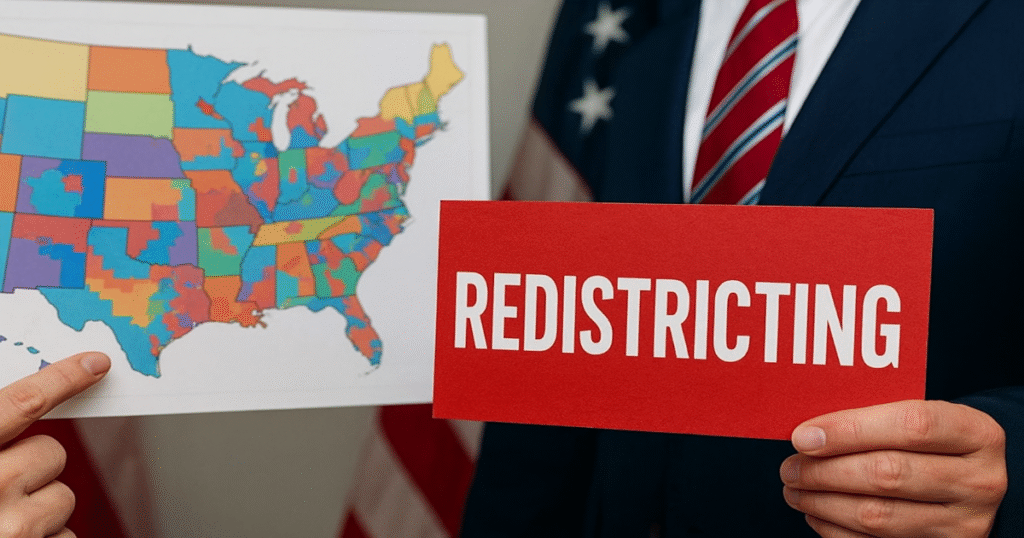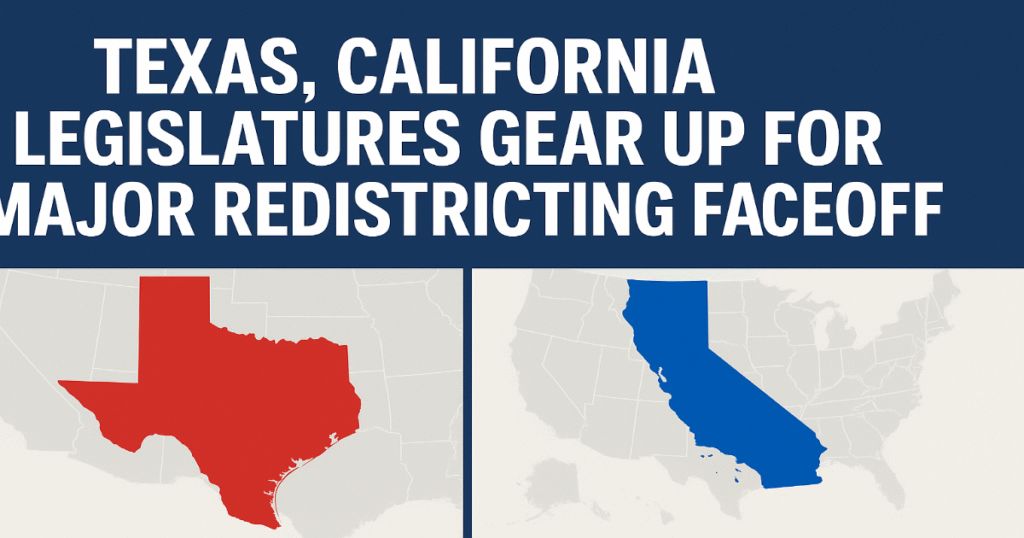
The battle over congressional maps in the United States is no longer confined to Texas. What started as a state-level push to secure more Republican-leaning seats has now evolved into a nationwide struggle, with both parties escalating their strategies in preparation for the 2026 midterm elections.
In recent weeks, Republicans have signaled a clear shift in focus. Texas was the first domino, but the GOP is now targeting other battleground and Republican-controlled states—including Missouri, Indiana, Florida, and Ohio—in an effort to redraw maps and expand their grip on the U.S. House of Representatives. Democrats, alarmed by the pace and aggressiveness of the Republican campaign, are mobilizing their own counteroffensive in blue strongholds such as California and New York.
This intensifying redistricting war is shaping up to be one of the most consequential political fights of the decade. It is not only about which party controls Congress after 2026—it is about the very structure of American democracy, the balance of political power, and the trust voters place in elections.
Texas: Ground Zero of the Redistricting Offensive
Texas has long been at the center of redistricting controversies, and once again, the Lone Star State has set the stage for the GOP’s new nationwide strategy.
Earlier this month, the Republican-controlled Texas House approved a new congressional map that could add as many as five additional GOP-leaning districts. Democrats staged a dramatic walkout to protest the plan, but the measure ultimately passed on a party-line vote. Now, the maps await final approval from the state Senate and Gov. Greg Abbott, both Republican allies of former President Donald Trump.
Trump himself has been unusually vocal about redistricting. In rallies and closed-door meetings, he has pushed Republican lawmakers to seize the moment, arguing that redrawing maps mid-decade is essential to ensuring long-term control of Congress.
“Republicans cannot afford to wait until 2030,” Trump told supporters at a recent rally in Dallas. “We need fair maps now—and we’re going to get them.”
Democrats, however, argue that “fair” is far from the right word. Critics say the Texas plan deliberately dilutes the political influence of Hispanic and Black voters, raising serious concerns about violations of the Voting Rights Act. Civil rights groups have already promised to challenge the new maps in court, setting the stage for protracted legal battles.
Despite the controversies, the Texas maneuver has emboldened Republicans in other states to pursue similar strategies.
Beyond Texas: GOP Eyes New Frontlines
With Texas in motion, Republicans are widening their scope. Their aim is clear: secure additional House seats in key states where the party holds legislative power.
- Missouri: State Republicans are preparing for a special legislative session that could result in at least one more GOP-friendly congressional district. Trump allies are applying pressure on local lawmakers, warning of primary challenges if they resist.
- Indiana: Trump’s influence is also visible here. Reports suggest he has threatened to back challengers against Republican legislators who oppose redrawing maps before 2030. The move has created tension within the party, as some establishment Republicans worry about potential backlash.
- Florida and Ohio: In these large, Republican-leaning states, committees are being formed to explore legal and constitutional pathways for mid-decade redistricting. Both states played pivotal roles in previous elections, and any new GOP-leaning districts there could have outsized national consequences.
- Nebraska: Though smaller, Nebraska’s single swing congressional district has often been a point of contention. Republicans there are reportedly discussing ways to redraw maps to make the district safer for the GOP.
Political analysts say this multi-state strategy is unprecedented. Redistricting traditionally happens once a decade following the U.S. Census. But Republicans, emboldened by Trump’s aggressive push, are breaking with tradition and testing the limits of state constitutions.
“Trump has essentially nationalized the redistricting fight,” explained Michael Li, a redistricting expert at the Brennan Center for Justice. “What used to be a technical, bureaucratic process has now become a central battleground in American politics.”
Democrats Strike Back: Blue States Enter the Fight
Republicans may have the upper hand in red states, but Democrats are not sitting idle. In fact, blue states are now moving to counterbalance the GOP’s offensive.
The most significant pushback is coming from California, where Gov. Gavin Newsom recently signed legislation calling a special election this November to approve a new congressional map. The plan could create up to five new Democratic-leaning districts, effectively canceling out Republican gains in Texas.
“This is a fight for the future of democracy,” Newsom said in a fiery press conference. “If Trump thinks he can gerrymander his way to permanent power, he’s in for a rude awakening. California will not stand by and let democracy be undermined.”
Other Democratic strongholds, including New York, Maryland, and Illinois, are weighing similar strategies. In some cases, independent redistricting commissions and state constitutions may make the process more complicated, but Democratic leaders are making it clear that they are prepared to respond aggressively if Republicans push forward.
House Minority Leader Hakeem Jeffries has also been outspoken on the issue. “If Republicans think they can tilt the playing field indefinitely, they are mistaken,” Jeffries said in a recent interview. “We will fight back in every state, in every court, and in every election.”
Democrats are also preparing for a legal showdown. The National Democratic Redistricting Committee, led by former Attorney General Eric Holder and backed by former President Barack Obama, is mobilizing lawsuits to challenge GOP maps they argue violate federal law.
A Polarized Chessboard
The intensifying redistricting battle is about more than just maps—it is a reflection of America’s deep political polarization.
Modern technology has made it easier than ever to draw districts with surgical precision. Sophisticated mapping software allows political operatives to slice neighborhoods street by street, creating districts that virtually guarantee a party’s dominance.
The result is fewer competitive races. Analysts warn that if current trends continue, as few as three dozen out of 435 House districts may remain truly competitive by 2026. That would leave the vast majority of voters in “safe” districts, where general elections are little more than formalities.
“This is not just about partisanship,” said David Wasserman, a senior analyst at the Cook Political Report. “It’s about the erosion of democracy. Voters are supposed to choose their representatives, not the other way around.”
The impact on minority communities is particularly concerning. In states like Texas, where the Hispanic population has grown rapidly, advocates argue that GOP maps are designed to suppress Latino political power. Lawsuits are already in motion, and federal courts may have to decide whether the new maps violate the Voting Rights Act.
Calls for Reform
The escalating battle has renewed calls for redistricting reform. Independent commissions, like those used in states such as California and Arizona, are often cited as models for removing partisanship from the process. But as both parties double down on aggressive tactics, the appetite for reform in state legislatures is limited.
Some political observers fear that the “arms race” in redistricting could spiral out of control. If both parties redraw maps every few years whenever they control state government, congressional boundaries could become a constant political weapon rather than a stable foundation of democracy.
“This is a dangerous path,” warned former Republican governor Arnold Schwarzenegger, a longtime advocate for redistricting reform. “If we allow politicians to keep manipulating maps for their own advantage, we are undermining the very foundation of fair elections.”
What Comes Next?
Looking ahead, the redistricting war is set to dominate the political landscape heading into 2026.
- Texas Lawsuits: Courts will soon weigh in on whether the state’s new maps violate minority voting rights.
- California Referendum: The November vote on new maps will be closely watched nationwide.
- Special Sessions: Missouri and Indiana could pass new maps as early as this fall.
- National Ripple Effect: Other states may follow, depending on how courts and voters respond to early cases.
The stakes could hardly be higher. With the House narrowly divided, even a handful of newly drawn districts could tip control of Congress. Beyond the immediate political consequences, however, lies a deeper question: how much faith will Americans continue to place in a system where political maps—not voters—seem to determine outcomes?
Conclusion
The Republican shift from Texas to a broader national redistricting strategy marks a new chapter in America’s political struggle. Democrats are responding in kind, setting up a clash that could reshape Congress for decades.
This is not just another partisan fight. It is a battle over the rules of the game itself—a high-stakes chess match that will test the strength of American democracy, the resilience of its institutions, and the patience of its voters.
As the fight spreads from Austin to Sacramento, from Indianapolis to Albany, one thing is certain: the redistricting wars of 2025 and 2026 will be remembered as a defining moment in the nation’s political history.
Also Read: Dems Flame Trump’s Proposed Chicago Crackdown: “No Authority”
Visit: Cheapest Sale

Hey I am Srimanta Pradhan brings 10 years of experience to News Broadcast and Marketing, specializing in effective communication.A specialized content writer with a decade of expertise crafting compelling narratives for News Broadcast and Marketing. Transforms complex information into engaging, impactful content.




















